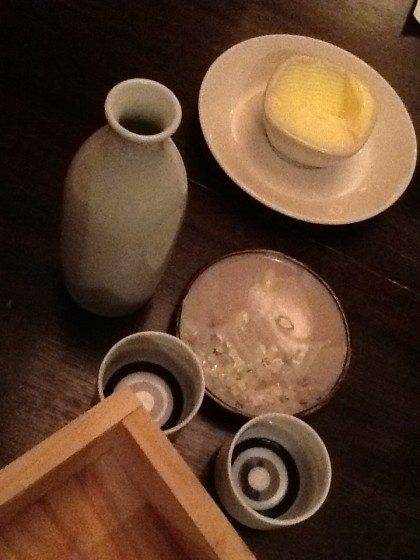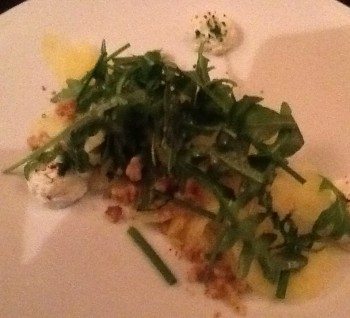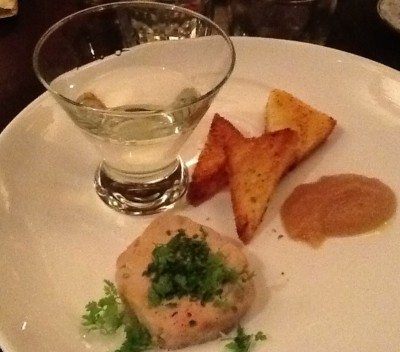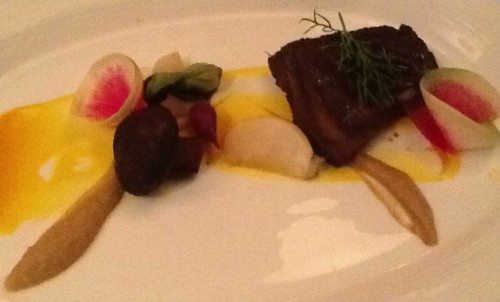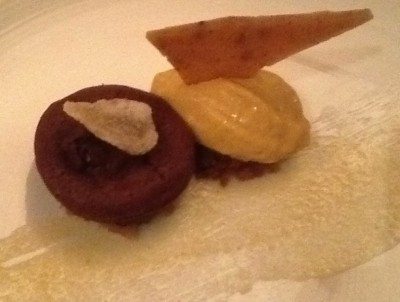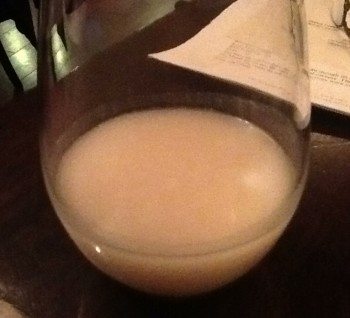Wine stemware was conspicuously absent at AKA Bistro’s sake and French cuisine dinner. On the table in front of me, next to a flask-like tokkuuri, were wood box masu, some kiki choko beaming their bottom-of-the-cup targets, and a flat ceremonial sakazuki drinking vessel. Of course, I would know little about any of this crystal-trumping nomenclature without the help of Rich Auffrey, The Passionate Foodie and sake expert. Irregardless, I pondered the table setting fully amused with its incongruous elements. See for yourself, what doesn’t belong?
Traditional sake drinking vessels and butter? Could French fare actually find it’s connection with rice wine? When AKA Bistro’s Christian Touche and Richard planned this sake and French cuisine pairing, they proceeded confidently and without concern for cultural or culinary collision. While I missed the other sake dinner in Rome, it seems like Japan’s Italian Embassy brass were also convinced that the savory flavors of Italian food could be heightened if paired with umami-rich sake. On this side of the ocean, our chefs went to work.
And Rich Auffrey’s sake selections chilled.
Curiosity intensified studying the food and sake menu.
Blue cheese mousse, apples, arugula, and reduced apple cider was produced with a namakaze, or unpasteurized sake, called “Cherry Peach Blossom”. The delicate mousse connected with the airy mouthfeel of the brightest, fruitiest, and freshest sake of the evening that seemed perfectly natural playing the role of salad escort. An impeccable pairing.
A rich and deeply flavored foie gras was paired with the umami laden and earthy sake called “Ferry Boat”, made from heirloom Watari Bune rice that had 55% of each husk remaining after the rice was milled down closer to the shinpaku (core). The pairing was brilliant; sake and foie gras folding into each other’s rotund and full bodied profiles.
Braised short ribs made it to the table accompanied by a Yamahai (omits the addition of lactic acid used to kill bad bacteria in the brewing process) Ginjo sake called “Crane of Ksaumi”. A gamey quality to this sake is, Rich explained, often detected in the lactic acid-free Yamahai style. This sake was the first and only to produce a comparison to grape wine that night as it flashed Burgundian. Rich suggested the depth of flavor in the accompanying mushrooms was most likely enhanced by the synergy between the sake’s and its own acidity…umami richness building on each other. A perfect pairing.
Chocolate biscuit and yuzu ginger puree with pumpkin ice cream followed to close out the meal. Rich paired a sweet milky Nigori sake, called Murai Genshu, that a majority of the dinner participants enjoyed. It was grainy in your mouth (lack of filtration?) and reminded me of a combination of soured Baileys Irish Cream and Milk of Magnesia. I really did not like it. Actually, it was repulsive; a personally undesirable pairing.
Impeccable, brilliant, and perfect pairings are not casual, every day assumptions. While Christian devised the food menu first, Rich was able to pair sake without ever tasting the dishes. The savory course pairings were so good, it can seem like a parlor trick to be able to create these ultimate food and wine marriages without tasting the dish and multiple sakes together in experimentation. While I have been bouncing around with Rich and his sakes for a few years now, it was this dinner that finally demonstrated the food pairing power stemming from sake’s ability to enhance food’s fifth umami taste on top of salty, bitter, sweet, and sour.
Sake, instead of wine, offers a totally different drinking and dining experience and creates the potential for pairing triumph and savory enhancement. For me, the underlying flavor of brewed rice could easily become a preference and recognizably enjoyable palate experience. But, on this night I missed the fruit in vinifera wines. Despite perfect, impeccable, and brilliant pairings I was interrupted by reflex associations between food and grape wine. I wondered how Pinot Noir or Sauternes would have been with the foie gras. Would a Rousanne/Marsanne blend been a better pairing than Godello with the salad? Would an aged claret or young Chateauneuf du Pape been more agile around the braised meat? For sure, any sweet grape wine would have been better with desert.
As you think about all this and maybe even try the sake pairing test yourself, maybe you will come to the same conclusion I did; “Sake, not wine, with French cuisine?” is a question unfairly posed. In different ways, both rice and vinifera wine are correct answers. I remember insisting that so many SAT multiple choice questions had two right answers. Well, this one does. Kanpai!

